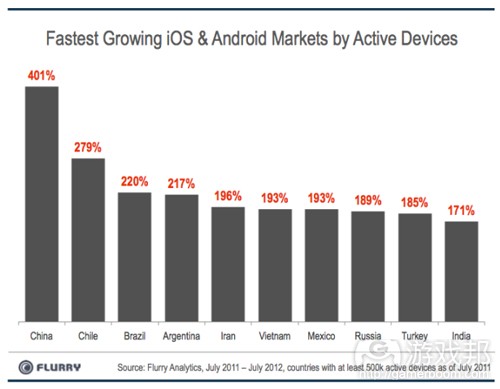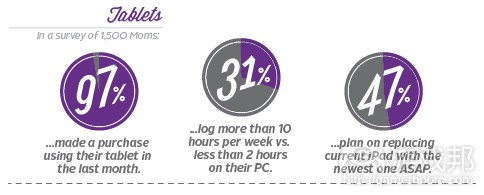每日观察:关注中国iOS和Android用户增幅全球第一(8.28)
1)Flurry最近报告显示,中美两国Android和iOS设备总数超过2.9亿部,预计中国用户增长速度将在今年底超越美国(游戏邦注:Flurry报告追踪了6.4亿部以上的20多万款应用,覆盖了全球90%以上的iOS和Android设备)。
美国iOS和Android新设备激活量同比去年增长3000多万部,在此期间中国设备激活量达到了1亿部。如果中国市场保持目前的增长速度,预计2012年假期季前中国设备激活量就可能超过美国。
截止今年7月,Flurry追踪了美国的1.65亿部活跃iOS和Android设备以及1.28亿部中国设备;美国的iOS和Android应用访问量也出现下滑趋势,从2011年7月的52%降至2012年的36%。而在此其间,中国iOS和Android活跃设备增幅达到401%,位居全球第一;位于其后的是智利,活跃设备增幅达279%。
尽管如此,中国iOS和Android设备市场覆盖率仍然低于美国,美国的iOS和Android设备覆盖率全球第五,有78%的成人用户持有这些智能手机。全球覆盖率最高的国家是新加坡,其iOS和Android活跃设备覆盖了92%的人口。
2)移动广告网站Mojiva最新报告显示,妈妈级用户与平板电脑、手机等设备的互动率极高。该用户群体中有三分之一拥有一台连网设备,平均每天在智能手机上投入时间达6.1小时,远超过在杂志、电视或广播等媒体上的投入时间。其中有62%使用购物应用,46%会在看到手机广告后采取消费行动(据Census数据显示,美国目前有8500万名母亲)。
Mojiva还发现这些拥有连网设备的妈妈用户的移动网络使用率比2009年多40%;超过60%持有智能手机的妈妈用户年龄介于25-44岁之间,其中白种人占比超过77%,西班牙裔占比12.4%,黑人占比11.5%,亚太岛民占比5.6%,印第安人占比1.2%。
收入超过10万美元的家庭移动设备覆盖率最高,但收入为2.5-5万美元的家庭移动设备覆盖率与收入为5-7.5万美元的家庭不相上下。在这些移动设备用户群体中,40%至少拥有大学学历,50%是全职工作者,62%拥有工作。
值得注意的是,没有智能手机的妈妈平均每天在移动设备上的投入时间也达到2.5小时,三分之一的妈妈拥有一部连网设备(非智能手机)。在这一群体中,9.8%是iPad有户,9.5%是Kindle用户,5.7%拥有iPod Touch。并且她们喜欢通过平板电脑购物。在接受访问的1500名平板电脑妈妈用户中,97%在最近一个月曾通过平板电脑网购。31%每周在平板电脑登录时间超过10小时,而在PC上登录时间不足2小时。
半数以上拥有连网设备的妈妈是社交媒体用户,她们当中有81%是某品牌粉丝,86%常更新状态,84%会在社交媒体发表评论。
3)据venturebeat报道,手机游戏开发商Pocket Gams日前发布最新游戏《Tap Campus Life》,其目标用户是少女及年轻女性。
玩家在这款iPhone游戏中可建立自己的女生联谊会,并召集好友加入。她们可以通过购物装饰游戏中的角色以及联谊会场所。
Pocket Gams至今已推出20款游戏,其中包括《Tap Pet Hotel》、《Tap Zoo》和《Paradise Cove》,该公司计划在今年夏季末将开发团队扩展至140人。
4)据pocketgamer报道,芬兰开发商Rovio最近推出一个以小猪为主题的Facebook页面及Twitter帐号。
该Facebook页面名称为Bad Piggies,但目前没有任何有关新游戏的信息,仅有一则“小猪厉害,小鸟真坏,我们喜欢鸟蛋”的声明。观察者称此举或意味着该公司可能将发布传闻中的“Angry Pigs”游戏。
5)据pocketgamer报道,芬兰开发商BeiZ日前宣布旗下的教育类游戏《Lola Panda》系列下载量已超过100万次,预计在未来数月将达200万次。
该系列游戏分别是《Lola’s Alphabet Train》、《Lola’s Beach Puzzle》以及最近发布的《Lola’s Math Train》(其创造下载量超过半数),目标用户是3-8岁幼儿群体。(本文为游戏邦/gamerboom.com编译,拒绝任何不保留版权的转载,如需转载请联系:游戏邦)
1)Flurry: China could have more iOS and Android devices than the U.S. by Christmas
Kathleen De Vere
Consumers in the U.S. and China own the most iOS and Android devices in the world — more than 290 million of them between the two countries — but China’s skyrocketing adoption rates could see it overtake the U.S. as the country with the most devices by the end of the year, says Flurry.
The company put together its latest report by logging how many devices in each country it detected running apps using its mobile analytics services. Altogether, Flurry tracks more than 200,000 apps running on more than 640 million devices, which Flurry claims allow it to reliably detect more than 90 percent of all the iOS and Android devices currently active in the world.
Year-over-year, more than 30 million new iOS and Android devices were activated in the U.S., but in the same time frame Chinese consumers activated an incredible 100 million new devices. If China keeps activating iOS and Android devices at the same pace, Flurry predicts it active install base will overtake the U.S. as early as the upcoming 2012 holiday season. As of July 2012, Flurry tracked 165 million active iOS and Android devices in the U.S. and 128 million in China. The U.S.’ share of total iOS and Android worldwide app sessions also declined, falling from 52 percent of all sessions in July 2011 to 36 percent in July 2012.
China’s seemingly insatiable taste for iOS and Android devices also makes it the fastest growing market in the world when compared to other fast-growing markets in South America and Eastern Europe. Between July 2011 and July 2012, the number of active iOS and Android devices in China increased by 401 percent. The next closest country was Chile, which registered 279 percent growth iOS and Android devices year-over-year.
Despite its explosive growth, the market for iOS and Android devices is also less saturated in China than it is in the United States. Flurry compared the number of active devices it tracked and compared that figure to each country’s adult population in order to determine which countries had the highest smartphone penetration. By that measure Flurry found that the U.S. has the fifth highest Android and iOS penetration in the world, with enough active devices to 78 percent of its adult population their own device. The world’s most saturated market was Singapore, which has enough active iOS and Android devices to give 92 percent of its adult population their own.
Overall while Flurry’s report doesn’t tell mobile app developers much that they didn’t already know, it still provides some interesting reference points for those who wish to know exactly how much potential is left in the rapidly growing, yet unsaturated Chinese market. While monetizing apps in the country is still a challenge, Flurry’s report shows that even if 0.05 percent of a company’s Chinese users ever monetize, the sheer size of the market alone could make it far more lucrative than many other countries.(source:insidemobileapps)
2)Report: One-Third Of U.S. Moms Own Connected Devices, 97% Of iPad Moms Shopped From Their Tablet Last Month
Sarah Perez
Remember when everyone in the tech industry sort of took a step back, looked at Pinterest, and said, whoa, this whole digital moms demographic might have some legs to it? Well, as it turns out, moms aren’t just out there pinning recipes and home decor to their Pinterest boards – they’re heavy-duty digital consumers across all channels, including not only social media, but also in e-commerce and on mobile.
According to the findings of a new report released today by mobile ad network Mojiva, moms are heavily engaged with their tablets and phones. One third own a connected device. They spend 6.1 hours per day on average on their smartphones – that’s more than magazines, TV or radio, to put it in perspective. 62% use shopping apps and 46% took action after seeing a mobile ads.
This an active, active group of users to target here.
Mojiva wanted to find out how engaged today’s moms were on mobile, and, like most of the U.S. population, their time spent on mobile is increasing. There are 85 million mothers in the U.S. according to Census data, says the firm, and of those who are mobile, they’re spending 6.1 hours per day on their smartphones. That number seems a little high, but to be fair – it’s an average and the more addicted mobile users could be throwing things off a bit. (In fact, 51% say they’re “addicted” to their smartphone).
In addition, Mojiva found that mobile web usage is 40% higher today than in 2009 for these connected moms – but that’s also more likely because of the increased rollout of mobile websites and phones that can access them. More important are the engagement numbers below.
But first, a few demographic details: over 60% of the moms toting smartphones are aged 25 to 44 and over 77% are Caucasian, followed by Hispanic (12.4%), Black (11.5%), Asian/Pacific Islander (5.6%) and Native American (1.2%). Household income, not surprisingly, increases the likelihood that the moms are mobile, with those in households over $100K more likely than others to be smartphone owners. However, here’s something interesting – households with income of $25K-$50K have just about the same mobile penetration levels among moms as those with household income of $50K-$75K. In other words, mobile is just a fact of life for these middle-class mothers. 40% of the mobile demographic has a university degree or higher, 50% work full-time and 62% work.
The really interesting numbers here are the engagement levels. Even moms without smartphones spend 2.5 hours on average per day on mobile. One-third of moms own a connected device (a non-smartphone). Of these, 9.8% own an iPad, 9.5% own a Kindle and 5.7% own an iPod Touch. And they like to shop from their tablet, too. In surveying 1,500 tablet-owning moms, 97% made a purchase using their tablet in the last month. That’s huge. 31% log more than 10 hours per week on their tablet but log less than 2 hours on their PCs. This is also reflective of the overall trend in the industry that is seeing tablets eat away at PC market share (and quickly). Despite this, many retailers have been shown to be slow to adapt, and are without tablet-ready websites or iPad apps. That leaves room for new companies to come in and give iPad shopping startups a shot, like Pickie for example, or Fab.com., Gilt, Shopmox, etc.
Plus, 62% of connected moms report using a shopping app, and 46% say they want to receive info on their mobile device while in a store.
Also not surprising to those who watch trends in this group closely, moms are heavy social media users as well. Half of connected moms use social media on their mobile. 81% of these are fans of a brand, 86% post status updates, and 84% comment on social media. That also offers brands and retailers a lot of opportunity to connect with this group to encourage purchases and other types of engagement – like re-posting and sharing.
This is fascinating data – especially if you’re looking to capitalize on one of the most engaged demographics out there with your new startup, app or e-commerce venture. For more info, or to access the complete report which sources some of the above data from research firms like Nielsen, Edison, and others, contact Mojiva.(source:techcrunch)
3)Pocket Gems launches Tap Campus Life mobile sorority game
Dean Takahashi
Mobile gamemaker Pocket Gems is publishing its latest game, Tap Campus Life, today in a bid to grab some of the market for girls and young women.
The free-to-play iPhone title enables gamers to build their own sorority on a college campus and recruit their friends to join it. Players can shop for fashions and create wardrobes for dozens of characters in the game. It’s another entry in the company’s “mobile first” strategy: creating games that run on smartphones and tablets. By targeting the game at female players, Pocket Gems is diversifying its product line and validating the fact that lots of girls and young women have become a big market on iOS (iPhone, iPad, iPod Touch).
“We feel we created a unique experience that is not similar to anything on the market,” said Ben Liu, the chief operating officer at Pocket Gems, in an interview with GamesBeat. “There are other games about college life targeted at teens, but we’ve tried to make a heavily customized experience.”
The new game follows a string of hits for Pocket Gems, including Tap Pet Hotel, Tap Zoo, and Paradise Cove. The game has its own backstory and allows for a lot of customization, as players can decorate more than just a single character. You can customize skin tones and hair and choose from thousands of different outfits to wear. And you can decorate your sorority mansion.
Pocket Gems felt like college life was an underserved genre on mobile devices.
“We created a brand-new engine for this game,” said Eric Lam, product manager at San Francisco-based Pocket Gems, in an interview with GamesBeat. “The player has the capability to create unique game play based on their own choices in the story.”
Pocket Gems is in the midst of doubling its engineering team, with the goal of hitting 140 employees by the end of the summer. The company has about 20 or so titles out now.(source:venturebeat)
4)Rovio launches Bad Piggies Twitter and Facebook pages. Will a game follow?
by Jon Jordan
It looks like Rovio’s much rumoured ‘Angry Pigs’ game is closer to its official announcement.
The Finnish developer has just launched a Facebook page for the piggies, and a Twitter account.
The former is entitled Bad Piggies, there’s no actual game news other than the statement that ‘Pigs are awesome. Birds stink. We like eggs!’
However, there were plenty of rumours at last week’s Unite 2012 conference in Amsterdam concerning the game so we’d expect more news will be breaking soon.
In the meantime, the Facebook page is here and Twitter here. (source:pocketgamer)
5)BeiZ’s Lola educational game range hits 1 million downloads
Expects to break 2 million barrier before end of 2012
by Jon Jordan
Given Finnish developer BeiZ’s games are educational, they’re not really core to the Pocket Gamer audience.
However, the news the company has now had over one million downloads in its Lola Panda series does go to show that focusing on your core – even if niche – market is crucial.
“The monthly growth for our games is over 10 percent. We are expecting to reach two million downloads in just a few months,” said CEO Mika Heikinheimo.
Counting your success
Games released to-date include Lola’s Alphabet Train, Lola’s Beach Puzzle, and most recently Lola’s Math Train, which has generated more than half of the total.
“It was very critical for us to create a polished concept and great artificial intelligence,” commented producer Miska Fredman.
“Children between 3 and 8 years old have totally different kinds of starting points and they enjoy different kinds of challenges when they start playing the games.”(source:pocketgamer)
















































